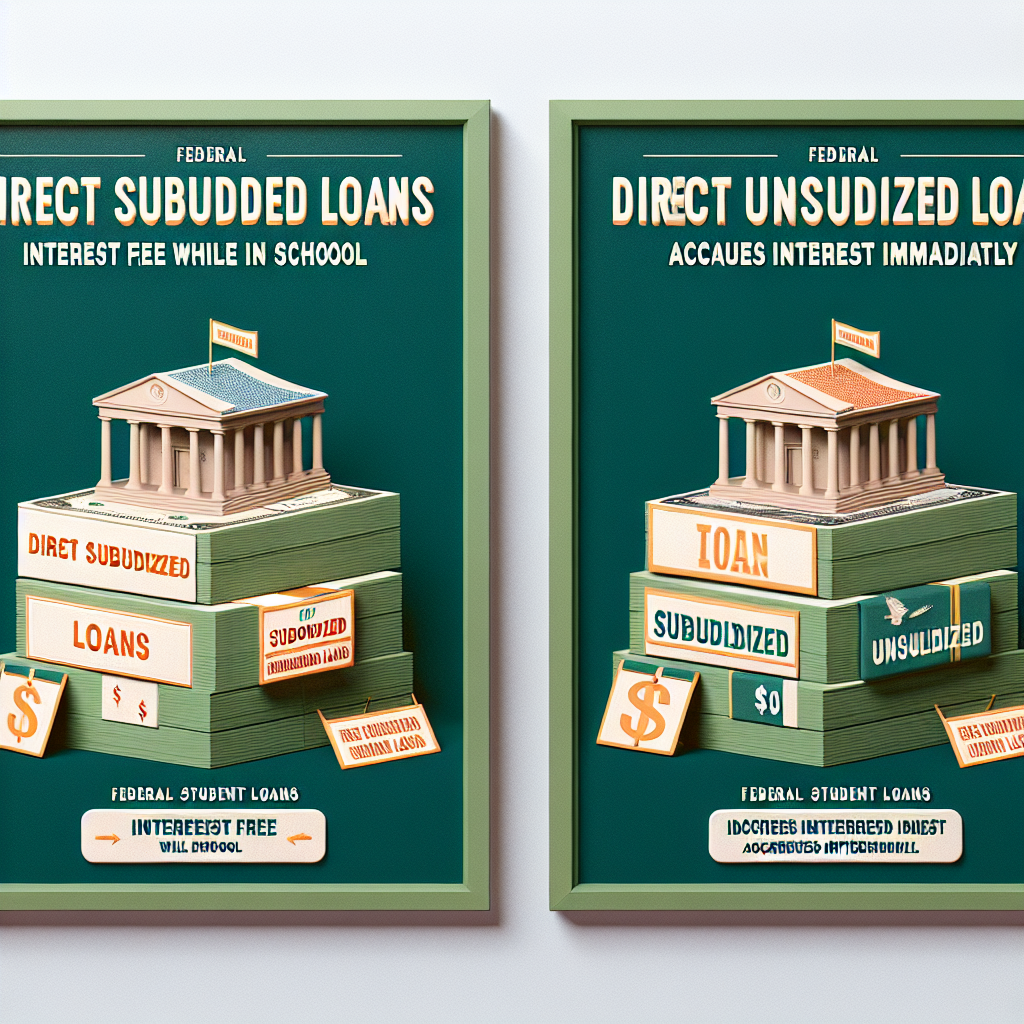
Direct subsidized loans and direct unsubsidized loans
Understanding Direct Subsidized Loans and Direct Unsubsidized Loans
When it comes to financing your education, understanding the types of federal student loans available is crucial. Among these, direct subsidized loans and direct unsubsidized loans play a significant role in helping students manage the costs of higher education. Each has its distinct features, eligibility requirements, and benefits that can greatly affect a borrower’s financial future. In this article, we will explore both types of loans, how they work, and their implications for students.
What are Direct Subsidized Loans?
Direct subsidized loans are federal student loans available to undergraduate students who demonstrate financial need. The government pays the interest on these loans while the student is enrolled at least half-time, during the grace period (typically six months after graduation), and during any deferment periods. This feature makes subsidized loans particularly attractive for low-income students.
Eligibility for Direct Subsidized Loans
To qualify for direct subsidized loans, students must meet several criteria:
- Be enrolled at least half-time in an eligible program at a college, university, or trade school.
- Demonstrate financial need as determined by the Free Application for Federal Student Aid (FAFSA).
- Be a U.S. citizen or an eligible non-citizen.
- Be registered with the Selective Service, if applicable.
Repayment Terms for Direct Subsidized Loans
The repayment terms for direct subsidized loans can be quite favorable:
- Standard repayment term is 10 years but can vary.
- Interest starts accruing once the borrower leaves school and enters repayment.
- Options for income-driven repayment plans are available.
What are Direct Unsubsidized Loans?
Direct unsubsidized loans are another type of federal student loan available to both undergraduate and graduate students. Unlike subsidized loans, these do not require the borrower to demonstrate financial need. While students can take advantage of these loans to help pay for their education, interest begins accruing as soon as the loan is disbursed, making them potentially more costly over time.
Eligibility for Direct Unsubsidized Loans
The eligibility requirements for direct unsubsidized loans are less stringent:
- Any student enrolled in an eligible program can apply, regardless of financial need.
- Students must also complete the FAFSA.
- Similar citizenship requirements apply as with subsidized loans.
Repayment Terms for Direct Unsubsidized Loans
The repayment terms for direct unsubsidized loans also have some flexibility, albeit with different implications:
- As with subsidized loans, the standard repayment term is typically 10 years.
- Interest accrues while the student is in school, during the grace period, and any forbearance periods.
- Also eligible for income-driven repayment plans.
Key Differences Between Direct Subsidized and Unsubsidized Loans
Understanding the fundamental differences between direct subsidized and direct unsubsidized loans is essential for making informed borrowing decisions. Here are the key distinctions:
| Criteria | Direct Subsidized Loans | Direct Unsubsidized Loans |
|---|---|---|
| Financial Need | Required | Not Required |
| Interest Payments While in School | Government pays interest | Borrower pays interest |
| Eligible Borrowers | Undergraduates only | Undergraduates and graduates |
| Interest Accrual During Grace Period | No interest accrues | Interest accrues |
| Loan Limits | Lower limits based on need | Higher limits available |
How to Decide Which Loan is Right for You
Choosing between direct subsidized loans and direct unsubsidized loans can be challenging. Here are some aspects to consider:
Evaluate Your Financial Situation
If you qualify for a subsidized loan, it’s generally the better option because the government covers the interest while you’re in school. However, if you need more funding than what is offered through subsidized loans, you might consider unsubsidized loans to fill the gap.
Consider Your Future Earnings
Think about your career prospects and potential income. Graduates in high-demand fields are likely to earn more, which may make it easier to manage repayment on unsubsidized loans.
Control Your Loan Amount
Try to borrow only what you need. Taking out loans can create financial burdens down the line, so it’s crucial to budget carefully and understand your limits.
The Application Process for Federal Loans
The process for obtaining federal loans is straightforward:
- Complete the FAFSA to determine your financial aid eligibility.
- Review your financial aid package, which will outline the types of loans and amounts you qualify for.
- Accept the loans and any other forms of financial aid you want to receive.
- Complete any additional required documentation, such as entrance counseling or a master promissory note.
Conclusion
In summary, both direct subsidized loans and direct unsubsidized loans have unique advantages and limitations that can significantly impact a student’s financial well-being. While direct subsidized loans are best for those who demonstrate financial need, direct unsubsidized loans offer more flexibility for varied types of students. Understanding your personal situation and evaluating your borrowing options is key to making the best choice for your educational financing.
Always remember to use loans responsibly and seek advice from financial aid advisors when needed. Your education is an investment in your future, and understanding how to manage your student loans is an essential skill that will serve you well well beyond your college years.
By Guest, Published on October 25th, 2024